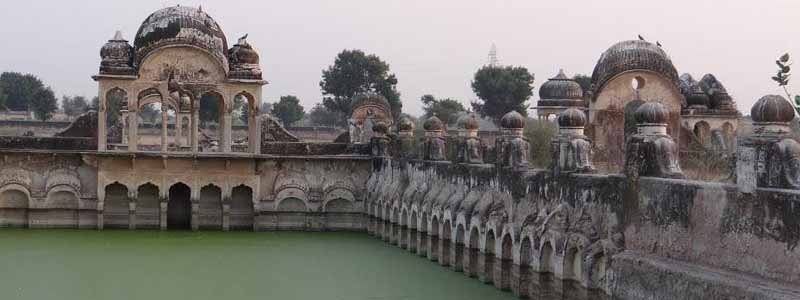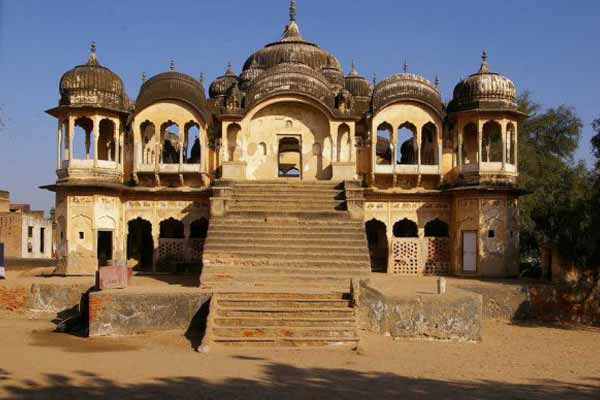Places to Visit in Churu, located in the desert state of Rajasthan, India, is a city steeped in history and architectural marvels. One of the prominent attractions is the Sethani Ka Johara, a massive water tank built in the 18th century by the wife of a wealthy trader. The intricate carvings and impressive architecture make it a captivating site for history enthusiasts.
The grand Ratangarh Fort is another must-visit destination, offering a glimpse into Churu’s historical significance. Constructed in the 18th century, the fort boasts stunning views of the surrounding landscape and showcases the region’s rich heritage.
For those interested in religious sites, the Salasar Balaji Temple is a renowned pilgrimage spot dedicated to Lord Hanuman. The temple’s serene atmosphere and spiritual ambience draw devotees from far and wide Rajasthan Monuments.
Churu is also famous for its havelis, with exquisite frescoes and intricate designs. The Kanhaiya Lal Bagla Haveli and Surana Double Haveli are prime examples, showcasing the architectural splendor of a bygone era.
Exploring the local markets, like the Ratangarh Cloth Market, provides an opportunity to experience the vibrant culture and traditional crafts of Churu. The city’s unique blend of history, architecture, and culture makes it a fascinating destination for travelers seeking an authentic Rajasthani experience.

Sethani Ka Johara:
“Sethani Ka Johara” refers to a historical stepwell located in Churu, Rajasthan, India. Stepwells, also known as baoris or bawdis, are common architectural structures in India used to collect and store rainwater. They were especially prevalent in regions with limited access to water.
The Sethani Ka Johara stepwell in Churu is renowned for its intricate architecture and historical significance. It was constructed during the 18th century by Sethani Narayani, the wife of a local nobleman. The stepwell served as a vital water source for the local community and also provided a place for people to gather and socialize Rajasthan Budget Tours.
The architecture of Sethani Ka Johara is characteristic of Rajasthani style, featuring elaborate carvings, arches, and balconies. The stepwell consists of multiple levels of steps leading down to the water reservoir, which would fill up during the monsoon season.
Today, Sethani Ka Johara is not only a historical monument but also a popular tourist attraction in Churu, drawing visitors who are interested in exploring the region’s rich cultural heritage.
Tal Chhapar Sanctuary:
The Tal Chhapar Sanctuary is located in the Churu district of the Indian state of Rajasthan. It is known for its unique ecosystem and is particularly renowned for being a habitat for the endangered and majestic bird species, the Great Indian Bustard (Ardeotis nigriceps).
This sanctuary is spread over an area of about 7 square kilometers and is characterized by flat saline depressions known as “tal” in the local language. The landscape consists of open grasslands interspersed with shrubs, which provide an ideal habitat for various species of wildlife, including birds, mammals, reptiles, and insects Tourist Places Rajasthan.
Apart from the Great Indian Bustard, the sanctuary is also home to other bird species such as the Black Francolin, Common Crane, and various species of larks, eagles, and vultures. Mammals like the desert fox, desert cat, and Indian hare can also be found here.
The Tal Chhapar Sanctuary is a popular destination for birdwatchers, wildlife enthusiasts, and photographers who visit to observe and photograph the diverse avian and mammalian life found in this unique ecosystem. The sanctuary is managed by the Rajasthan Forest Department and is open to visitors throughout the year, although the best time to visit is during the winter months when migratory birds arrive at the sanctuary.
Ratangarh Fort:
Ratangarh Fort is a historical fort located in the town of Ratangarh in the Churu district of the Indian state of Rajasthan. It is situated on top of a hill and is known for its architectural grandeur and historical significance.
The fort was built in the 18th century by the Rathore rulers of Bikaner. It is a massive structure with high walls and several bastions. The fort has several palaces, temples, and other buildings within its premises, showcasing the rich heritage and culture of the region.
Ratangarh Fort has witnessed many battles and sieges over the centuries due to its strategic location. It served as a military stronghold for the Rathore rulers and later came under the control of the British during the colonial period Places to Visit in Churu.
Today, Ratangarh Fort stands as a prominent tourist attraction, drawing visitors with its impressive architecture, historical significance, and panoramic views of the surrounding area. It offers a glimpse into Rajasthan’s royal past and is a must-visit destination for history enthusiasts and architecture lovers.
Churu Fort:
Churu Fort, also known as Churu Garh, is a historical fort located in the town of Churu in the state of Rajasthan, India. The fort is situated atop a hill and is a prominent landmark in the region. It was built in the 17th century by the Rajput ruler, Thakur Kushal Singh, who belonged to the Rathore clan.
Churu Fort is characterized by its impressive architecture, with massive walls and bastions surrounding the complex. The fort has several gates, including the Surajpol and the Kishanpol, which are adorned with intricate carvings and designs. Within the fort, there are various structures such as palaces, temples, and residential quarters.
The fort offers panoramic views of the surrounding landscape and is a popular tourist attraction in Churu. Visitors can explore the fort and learn about its history and significance in the region. Additionally, the town of Churu itself is known for its well-preserved havelis (traditional mansions) and colorful frescoes, making it a destination rich in heritage and culture.
Sethaniyon Ki Haveli:
“Sethaniyon Ki Haveli” translates to “Mansion of the Sethanis” in English. Churu is a city in the state of Rajasthan, India, known for its rich heritage and stunning architecture, including havelis (traditional Indian mansions).
Unfortunately, without specific information about a particular haveli named “Sethaniyon Ki Haveli” in Churu, I’m unable to provide detailed information. However, it’s common for havelis in Rajasthan to be named after the families or individuals who built or owned them.
If you’re interested in visiting or learning more about a specific haveli named “Sethaniyon Ki Haveli” in Churu, I recommend conducting further research or reaching out to local tourism authorities or historical societies in Churu for more information Places to Visit in Churu.
Surana Haveli:
Surana Haveli is a historic mansion located in the town of Churu in the state of Rajasthan, India. Churu is known for its rich heritage of havelis (traditional Indian mansions) adorned with intricate frescoes and architectural beauty.
Surana Haveli is one such haveli that showcases the traditional Rajasthani architecture and design. It is renowned for its stunning frescoes, which depict scenes from Indian mythology, local legends, and everyday life. The haveli is an architectural marvel, with intricately carved facades, ornate balconies, and jharokhas (overhanging enclosed balconies) that exemplify the craftsmanship of yesteryears.
Visitors to Surana Haveli can admire the vibrant frescoes that adorn its walls, showcasing the artistic prowess of the artisans of that era. The haveli provides a glimpse into the opulent lifestyle of the affluent merchants and nobles who once resided there.
Today, Surana Haveli stands as a testimony to Churu’s glorious past and serves as a popular tourist attraction, attracting visitors from around the world who come to marvel at its architectural splendor and exquisite artwork.
Jagmalasar Lake:
Jagmalasar Lake is a significant water body located in the Churu district of the Indian state of Rajasthan. Churu is known for its semi-arid climate, and lakes like Jagmalasar play a crucial role in providing water for irrigation and other purposes in the region Places to Visit in Churu.
Jagmalasar Lake is a man-made reservoir that serves as a water source for nearby villages and agricultural lands. It plays a vital role in sustaining the local ecosystem and supporting agricultural activities in the region. The lake also serves as a habitat for various species of birds and other wildlife.
In addition to its practical significance, Jagmalasar Lake also holds cultural and recreational value for the local community. It is a common gathering spot for locals and visitors alike, offering opportunities for activities such as boating and picnicking.
Efforts are often made to maintain and preserve the lake’s ecosystem, including initiatives for water conservation and environmental protection. Protecting water bodies like Jagmalasar Lake is essential for ensuring the sustainable development of regions like Churu, especially in the face of challenges such as water scarcity and climate change.
Salasar Balaji Temple:
Salasar Balaji Temple is a famous Hindu temple located in Salasar, a village in the Churu district of the Indian state of Rajasthan. It is dedicated to Lord Hanuman, a revered deity in Hinduism known for his strength, courage, and devotion to Lord Rama.
The temple is particularly popular among devotees who believe in the power of Lord Hanuman to fulfill their wishes and provide protection. It is believed that visiting the temple and offering prayers with devotion can help in overcoming obstacles and difficulties in life Places to Visit in Churu.
The temple complex includes the main shrine of Lord Hanuman, along with other smaller shrines dedicated to various Hindu gods and goddesses. The temple attracts a large number of devotees throughout the year, especially during festivals like Hanuman Jayanti and during the auspicious days of Saturdays.
The architecture of the temple reflects traditional Rajasthani style, with intricate carvings and decorations adorning the walls and pillars. The temple premises also include facilities for accommodation and meals for pilgrims and visitors.
Salasar Balaji Temple holds significant cultural and religious importance in the region, and it remains a cherished pilgrimage destination for devotees seeking blessings and spiritual solace.
Mehansar:
Mehansar is a small village located in the Churu district of the Indian state of Rajasthan. It is known for its beautifully decorated havelis (traditional Indian mansions) that showcase intricate frescoes and architectural marvels. These havelis date back to the 18th and 19th centuries and were built by wealthy merchants and traders of the region.
The frescoes adorning the havelis depict a blend of Rajasthani, Mughal, and European artistic influences, depicting scenes from mythology, daily life, and historical events. The intricate detailing and vibrant colors used in these frescoes make Mehansar a popular destination for tourists interested in heritage and architecture Places to Visit in Churu.
In addition to the havelis, Mehansar also has a few temples and step wells that add to its historical and architectural significance. The village offers visitors a glimpse into the rich cultural heritage of Rajasthan and is a must-visit for those interested in exploring off-the-beaten-path destinations in India.
Shyam Kund:
Shyam Kund is a historical stepwell located in the town of Churu in the Indian state of Rajasthan. Stepwells are unique to the Indian subcontinent and were traditionally used to store water and provide relief from the heat. Shyam Kund is known for its architectural beauty and historical significance. It is believed to have been built during the 19th century. The stepwell is named after the Hindu god Krishna, who is also known as Shyam. It features intricate carvings and sculptures that depict scenes from Hindu mythology. Shyam Kund is not only a source of water but also a cultural and historical landmark in Churu, attracting tourists and history enthusiasts alike.
